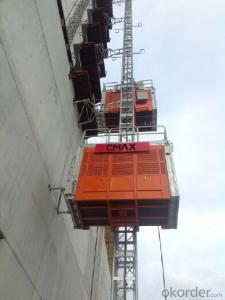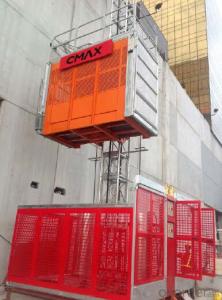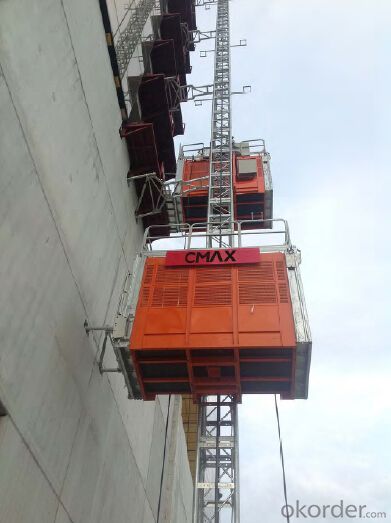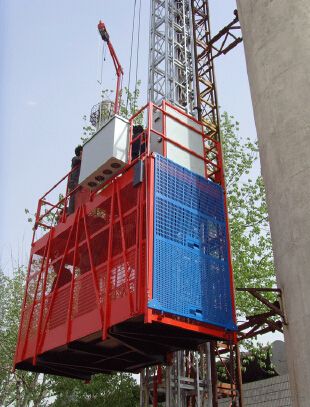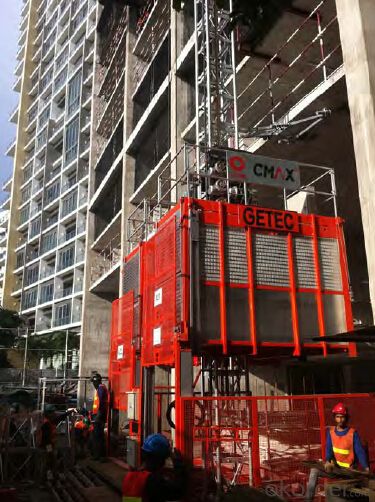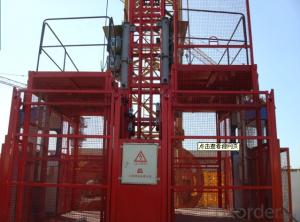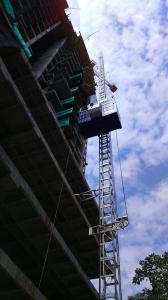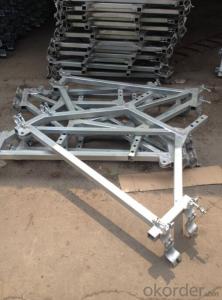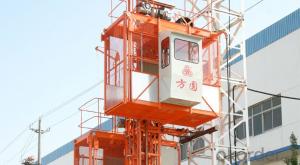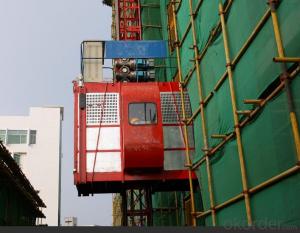1200kg Painted Building Material Twin Cage Hoist 3.6 x 1.5 x 2.5m SC120/120
- Loading Port:
- Tianjin
- Payment Terms:
- TT or LC
- Min Order Qty:
- 1 unit
- Supply Capability:
- 2000 unit/month
OKorder Service Pledge
OKorder Financial Service
You Might Also Like
SC200/200 3*2*11kw building electric hoist
Descriptions of our building hoist:
The general building hoist manufactured by our company have the features as good quality, long life, wide application range and convenient for maintenance, the gering adopts imported bearing, enameled cable, and oil seal, the electric parts adopt products from world renowned manufactures such as Schneider, Siemens, and LG, the racks and pinion adopts special material and heat-treatment technique, which prolong the life of these parts. The steel structure uses quality steel from famous domestic manufacturers, the surface of the structure can apply paint-spray, Parkerizing baking finish or hot galvanizing processing according to users requirements, the cage can be produced and decorated by aluminum molded board, punched-plate or figured aluminum board.
Main Features of Building Material Hoist
1. the recommended cage dimension(LXWXH):2.0X1.0X2.5, 2.5X1.0X2.5, 2.5X1.3X2.5, 3.0X1.5X2.5, 3.2X1.5X2.5, 3.8X1.5X2.5, 4.0X1.5X2.5, 4.2X1.5X2.5 etc, we can also manufacture cages of other size according to the user.
2. The cage and the door material can be aluminum molded board, punched-plate, figured aluminum board or other type according to your requirements.
3. The mast and the tie-in surface can adopt paint-spray, or hot galvanizeing processing.
Advantage of our building hoist:
1. Our own systems of production engineering.
2. Production design from the concept to the engineering details.
3. Technical experts with great experience in the sector.
4. Continuous development of new solutions and products adapted to the requirements of our clients.
5. Methodology and project procedure administration in compliance with current guidelines.
6. Extensive worldwide commercial network
Specification of our building hoist:
SC120/120 BUILDING HOIST,CAPACITY 1200KG,SPEED 0-36 M/MIN,STEEL WITH PAINTING MAST SECTION,CABIN 3.6 *1.5*2.5M
SC120, SC200, SC200/200 building hoist:
1). Cage load capacity: 2, 000kg
2). Lifting speed: 36m/min, 0 - 63m/min, 0 - 96m/min
3). Mast section: Painted or hot dipped zinc
4). Cage: Single cage or twin cage
5). Recommended cage inner dimensions (L x W x H): 2.5 x1.3 x 2.5m, 3.0 x 1.3 x 2.5m, 3.2 x 1.5 x 2.5m, 3.6 x 1.5 x 2.5m, 3.8 x 1.5 x 2.5m, 4.0 x 1.5 x 2.5m, 4.2 x 1.5 x 2.5m, according to requirements of customers
6). Motor and reducing device: Made in China, or uses SEW according to requirements
7). Counterweight: With counterweight or without counterweight
8). Color of cage: Yellow, red, blue
9). Cage load capacity: 1, 000kg, 1, 200kg, 2, 000kg, 2, 700kg or 3, 200kg
10) including VFD or without VFD.
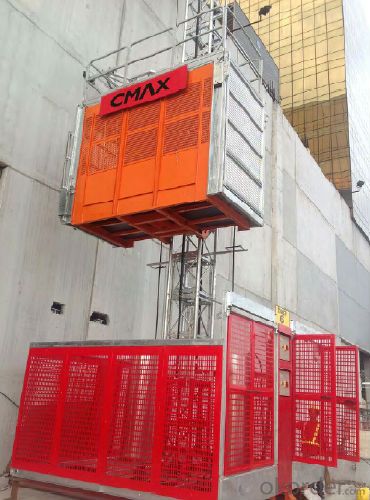
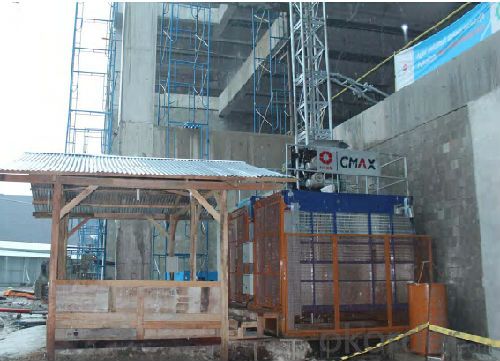

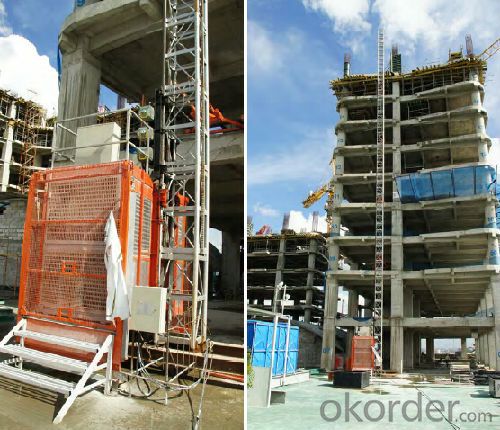
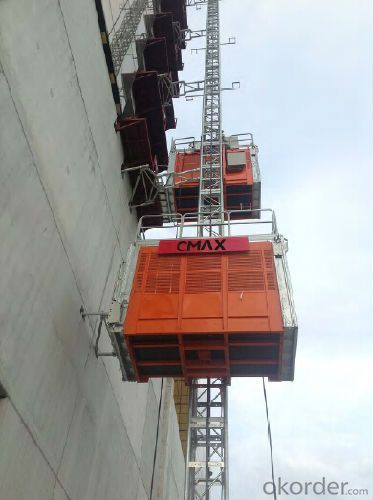
Production line
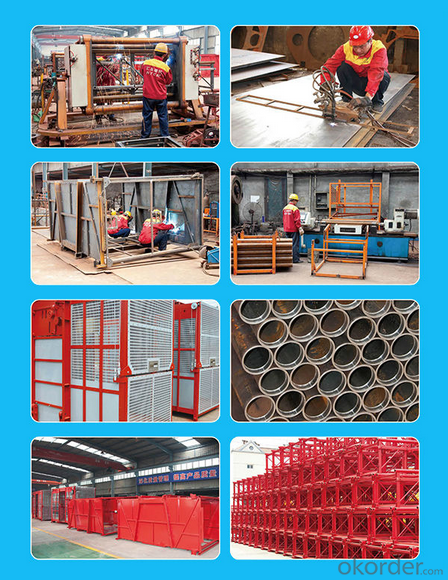
FAQ
1. why chose us?
China National Building Materials (Group) Corporation (CNBM), established in 1984,now is one of the largest state-owned group corporation in China, dealing with building materials & industrial equipment. Up to year 2010, CNBM Group's total asset is 20 billion USD and total staff is more than 100,000.CNBM International Corporation, specializes in designing & manufacturing of various
kinds of construction machinery, including tower crane, building hoist, etc. All the equipment produced by CNBM are compliant with the National level quality standard, and wins great reputation for their endurable performance in worldwide markets.
2.How about the shipment?
You can put 2 sets of of wheel loaders in one 40HQ container. The spare parts are packed with boxes.
The delivery time is 20 days.
3. What about your service?
We have our factory, we can meet customers needs as soon as possible.
We have first rate professional technology and provide good after-sales service.
4.After Sales Service
We offer the Preventative Maintenance and After Sales Service. For we strongly feels about the importance of supporting our customers and the product solutions we provide. Consequently we offer comprehensive maintenance options to prevent equipment issues before they become problems. Also we offer one year guarantee period.
- Q: This question asks whether a building hoist can develop operational issues due to incorrect usage or lack of maintenance.
- <p>Yes, a building hoist can malfunction due to improper use or inadequate maintenance. Improper use may include overloading the hoist, using it in unsuitable conditions, or operating it without proper training. Inadequate maintenance can lead to wear and tear, lubrication issues, and component failures. Regular inspections, proper usage guidelines, and timely repairs are crucial to prevent malfunctions and ensure the safety of the hoist and its operators.</p>
- Q: The difference between the derrick and the construction elevator?
- You want the picture to still want to explain, the words to go to baidu search all can. The derrick is not to be multiplied by the person, the setting height is not more than 30 meters, now most of the place begin to phase out the use of the derrick, because the safety coefficient is low. The construction elevator can carry cargo, set up a height of 150 meters, and can carry a weight of 1-3 tons
- Q: This question seeks to understand the various types of electric lifting equipment utilized in the construction industry.
- <p>In the construction industry, various types of electric lifting equipment are used to facilitate the movement of heavy materials and equipment. Some of the common types include: 1. Electric Hoists: These are used for vertical lifting and lowering of loads. 2. Electric Cranes: They are mobile lifting machines with a long boom and can move loads horizontally and vertically. 3. Electric Forklifts: They are used for lifting and transporting heavy loads in a warehouse or construction site. 4. Electric Scissor Lifts: These are mobile platforms that can be raised to allow workers to reach high areas. 5. Electric Stackers: Used for stacking and unstacking materials in a warehouse. 6. Electric Pallet Trucks: These are used for moving heavy pallets of materials. Each type of equipment serves a specific purpose and is chosen based on the requirements of the construction project.</p>
- Q: This question asks for the process of changing the speed at which a building hoist cylinder operates.
- <p>Adjusting the speed of a building hoist cylinder involves several steps. First, ensure the hoist is turned off and disconnected from power. Check the manual for the specific model to understand the speed control mechanism, which could be a variable frequency drive (VFD), a governor, or a throttle control. If it's a VFD, adjust the frequency setting to increase or decrease speed. For a governor, you might need to change the spring tension or adjust the control valve. With a throttle control, simply turn the throttle to the desired speed setting. Always test the hoist at low loads first to ensure the adjustments are safe and effective before using it for heavy loads.</p>
- Q: When does the construction elevator take off?
- This is not specific time, it is the contractor's own
- Q: What specific regulations or conditions must be met when utilizing lifting equipment in construction or factory environments?
- <p>Yes, there are special requirements for using lifting equipment in construction sites and factories. These include adherence to safety regulations, regular maintenance and inspection, proper operator training, and ensuring the equipment is suitable for the task. Compliance with local and national laws such as OSHA in the U.S. or CE marking in the EU is crucial. Equipment must be certified safe for use, and operators must be licensed and follow safety protocols. Additionally, load capacities must be respected, and lifting operations must be planned and supervised to prevent accidents.</p>
- Q: This question asks about the precautions and safety protocols that should be followed when using lifting equipment in construction projects.
- <p>Safety measures for using lifting equipment in construction work include regular inspections and maintenance of the equipment, ensuring all safety features are in place and functioning correctly. Operators must be trained and certified for the specific type of lifting equipment they are using. Load limits should never be exceeded, and all loads must be secured properly. Safe operating procedures should be followed, such as not lifting loads over people and maintaining a safe distance from power lines. Personal protective equipment (PPE) must be worn by operators and workers in the vicinity. Emergency procedures should be established and communicated to all workers. Regular safety briefings and training sessions should be conducted to keep safety at the forefront of all operations.</p>
- Q: This question asks for guidance on selecting appropriate lifting equipment based on specific requirements and work conditions.
- <p>To choose the right type of lifting equipment for your specific needs and work environment, consider the following: 1. Load capacity: Ensure the equipment can handle the weight of the items you need to lift. 2. Workspace: Evaluate the size and layout of your work area to determine the appropriate size and type of equipment. 3. Safety features: Look for equipment with safety features that meet your industry's standards. 4. Mobility: Consider whether you need a mobile or stationary unit. 5. Compatibility: Ensure the equipment is compatible with other tools or machinery you use. 6. Budget: Determine your budget and find equipment that offers the best value for your investment. 7. Consult with experts: Speak with equipment manufacturers or distributors to get their recommendations based on your specific needs. Always prioritize safety and efficiency when selecting lifting equipment.</p>
- Q: What precautions should be taken on construction sites when operating a building hoist?
- <p>Safety measures for using a building hoist in construction sites include regular inspections and maintenance to ensure the hoist is in good working condition. Operators must be trained and certified to use the hoist. Safety barriers or gates should be installed to prevent unauthorized access. Load limits must be strictly adhered to, and overloading is prohibited. Emergency stop buttons should be easily accessible. Workers should wear appropriate personal protective equipment (PPE). Regular safety briefings and training sessions should be conducted to keep workers informed about safe hoist operation procedures.</p>
- Q: This question asks whether a building hoist can be utilized for lifting both fragile and non-fragile items.
- <p>Yes, a building hoist can be used for lifting both fragile and non-fragile objects. However, it is crucial to ensure that the hoist is equipped with the appropriate attachments and safety measures to handle fragile items without causing damage. For non-fragile objects, the hoist can be used more freely, but still, safety protocols must be followed to prevent accidents. The key is to use the hoist within its weight capacity and to adhere to all operational guidelines to ensure the safe and effective lifting of all types of objects.</p>
Send your message to us
1200kg Painted Building Material Twin Cage Hoist 3.6 x 1.5 x 2.5m SC120/120
- Loading Port:
- Tianjin
- Payment Terms:
- TT or LC
- Min Order Qty:
- 1 unit
- Supply Capability:
- 2000 unit/month
OKorder Service Pledge
OKorder Financial Service
Similar products
Hot products
Hot Searches
Related keywords
